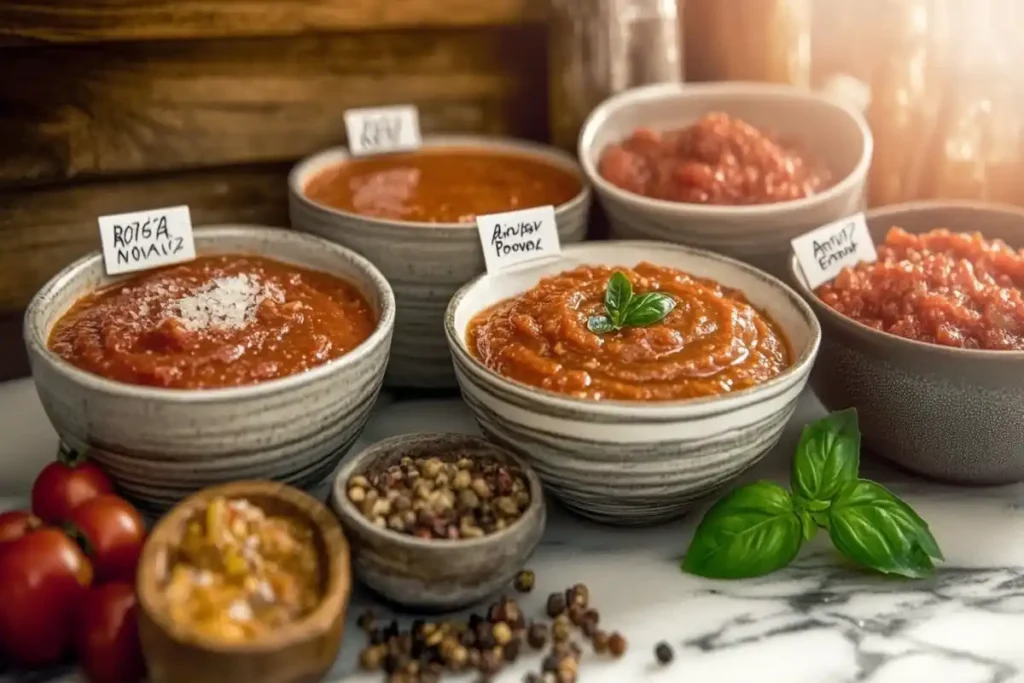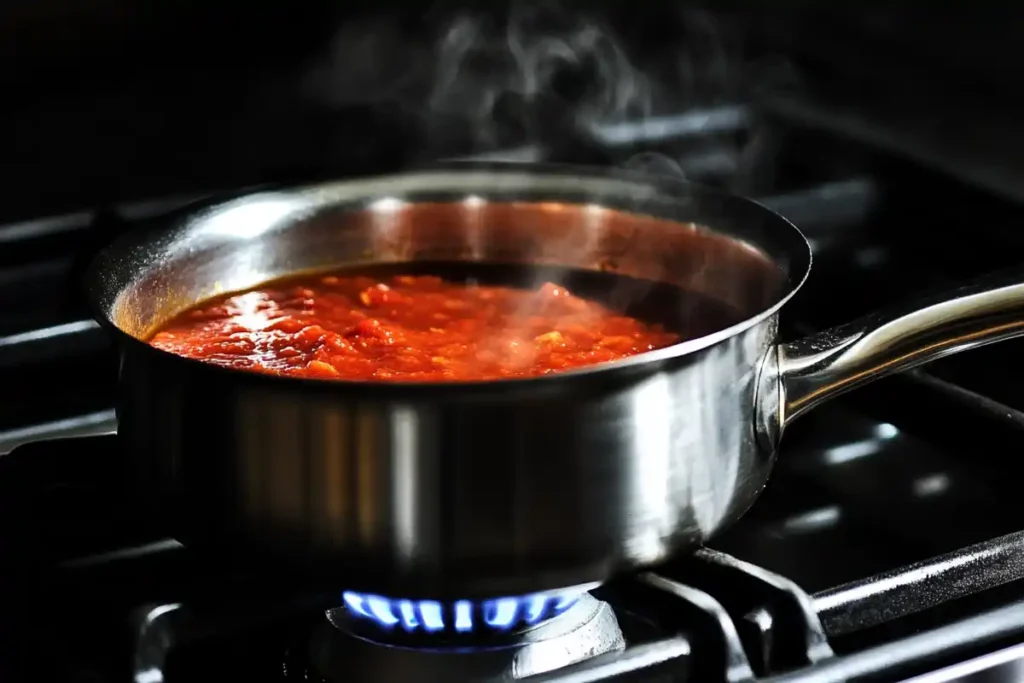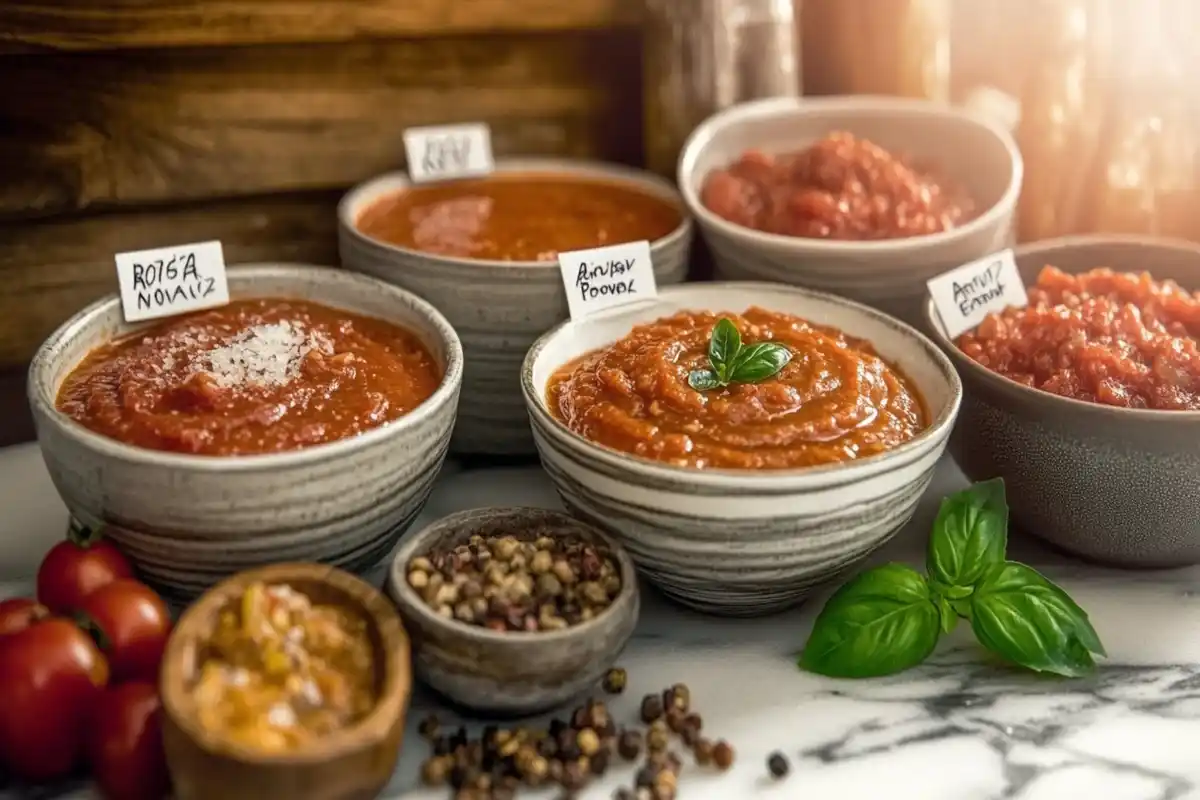Alright, let’s be real—tomato sauce isn’t just a pantry staple… it’s basically the heart and soul of comfort food. Whether you’re throwing together a quick spaghetti on a weeknight or simmerin’ up a rich Sunday gravy that makes the whole house smell like heaven, this saucy legend’s got your back.
I mean, think about it—how many meals have started with, “Just grab the tomato sauce”? Exactly. From cozy pastas to bubbling lasagnas, tomato sauce is that reliable go-to we all turn to. And the cool part? It’s crazy simple to make from scratch, but still feels like a total flex when you do.
In this mega guide, I’m breaking’ it all down: the history (because who doesn’t love a little food trivia?), every type of tomato sauce worth knowing, how to whip it up like a pro, and yeah—what to avoid so your sauce doesn’t taste like sad cafeteria spaghetti.
The Origins of Tomato Sauce
So here’s the thing—most folks automatically think of Italy when they hear “tomato sauce,” right? And yeah, they definitely took it to the next level with dishes like marinara and Bolognese. But the real origin story? It goes way, way further back.
From Ancient Aztecs to Italian Kitchens
Long before tomatoes hit European kitchens, they were already a big deal in Mesoamerica. We’re talking way back—like, the Aztecs were out here grinding up tomatoes and mixing ’em with chilies, herbs, and other good stuff. Basically, they were the OGs of salsa.
Now, here’s where it gets interesting: tomatoes didn’t even exist in Europe until the 1500s. Spanish explorers brought them over after hangin’ out in the Americas. At first, Europeans were like, “Uhh… can we even eat these?” A lot of folks thought tomatoes were poisonous—seriously! Turns out, they were just freaked out by how acidic tomatoes were with their fancy pewter plates (which leached lead, yikes).
The Evolution in Italian Cuisine
Fast-forward a little—by the late 1600s, Italians finally said, “Hey, maybe we cook these bad boys instead of fear them.” And boom, the first actual tomato sauce recipes started showing up in Southern Italy.
It wasn’t love at first bite, though. For a while, tomato sauce was seen as peasant food—super cheap, super simple. But ya know what? That’s kind of what makes it so great. Even today, the best sauces use just a few fresh ingredients. No frills. Just real flavor.
And before we move on—quick fun fact: the classic Neapolitan marinara? Yeah, it doesn’t even have meat in it. Just tomatoes, garlic, oregano, and olive oil. That’s it. And it still slaps.
Types of Tomato Sauce You Gotta Know

Classic Marinara – The Weeknight Wonder
Alright, if tomato sauce had a “starter pack,” marinara would be front and center. It’s quick, it’s easy, and it goes with everything—pasta, pizza, meatballs, you name it.
What’s in it?
- Crushed tomatoes
- Garlic
- Onion (sometimes)
- Olive oil
- Fresh basil or oregano
Pro tip: Wanna impress someone without breaking a sweat? Simmer this for 20–30 minutes, and your kitchen will smell like a trattoria in Naples.
Rich & Hearty Bolognese – The Sunday Showstopper
Okay, so Bolognese isn’t your quick-fix sauce. This one’s a commitment—but oh man, is it worth it. It’s thick, meaty, and built for pasta like tagliatelle or pappardelle.
What goes in it?
- Ground beef
- Onions, carrots, and celery (aka “soffritto”)
- Tomato paste or crushed tomatoes
- Milk or cream (yes, really)
Low and slow is the name of the game. Let this baby simmer for at least 2 hours so all those flavors get cozy.
Spicy Arrabbiata – The Hothead in the Family
“Arrabbiata” literally means “angry” in Italian—and yeah, this sauce brings the heat. If you’re into spice, this one’s your jam.
Ingredients:
- Tomatoes (duh)
- Garlic
- Crushed red chili flakes
- Olive oil
It’s usually paired with penne (penne all’arrabbiata, anyone?) and takes less than 30 minutes to whip up. Simple, bold, and it definitely wakes up your taste buds.
Pomodoro – The Fresh and Fancy Vibe
Now, if marinara is the go-to, pomodoro is her breezy, minimalist cousin. It’s smoother, usually cooked with fresh tomatoes, and often used in higher-end dishes that wanna show off those bright tomato notes.
What’s in it?
- Fresh tomatoes (blanched and peeled)
- Olive oil
- Garlic
- Fresh basil
Pomodoro = tomato in Italian, so it’s really just the purest version of tomato sauce you can make. Serve this over thin pasta like angel hair or spaghetti for a light, elegant plate.
Bonus: Sauce Hybrids & Regional Twists
Some sauces mix things up, like:
- Putanesca: Tomatoes + olives + capers + anchovies
- Sauce: A creamy tomato-(yep, it actually helps balance the acidity)
- Amatriciana: Tomatoes with guanciale and pecorino cheese
Honestly, once you master the base, you can tweak it a million ways.
Health Benefits of Tomato Sauce (Yup, It’s Good for You!)
Look, I’m not saying tomato sauce is the next superfood (we’re not that dramatic here)… but it’s got some legit nutrition points. Especially if you’re making it fresh and keeping it simple.
Packed with Vitamins & Antioxidants
Tomatoes are loaded with:
- Vitamin C (hello, immune system!)
- Vitamin A (great for your skin and eyes)
- Potassium (a must for healthy muscles and heart)
- Folate (especially important if you’re expecting)
But the real MVP here? Lycopene. It’s that bright red pigment in tomatoes, and it’s been linked to lowering the risk of heart disease and certain cancers.
Fun fact: Cooking tomatoes actually boosts lycopene levels, so your simmered sauce might be even healthier than raw tomatoes. Pretty wild, right?
Low-Cal, High Flavor
Let’s say it: we all love food that tastes like a cheat meal without actually being one. Tomato sauce is low in fat and calories, but brings so much flavor.
- A basic marinara clocks in around 70–100 calories per half-cup.
- Swap cream sauces for tomato sauce to save calories without losing taste.
- If you’re watching your sodium, just go easy on the salt (especially if using canned tomatoes).
Heart-Lovin’ Goodness
Lycopene isn’t just for cancer prevention—it’s also a friend to your heart. Studies suggest it helps reduce bad cholesterol (LDL) and supports blood vessel health.
And don’t forget: adding olive oil, garlic, and herbs like oregano or basil? That’s like layering health benefits on top of flavor bombs.
Mood and Brain Support? Yep.
This one’s still being researched, but some studies hint that tomatoes may play a role in reducing depression symptoms and improving mood. Could be thanks to the antioxidant combo and folate. Either way, if a cozy bowl of pasta makes you feel good, that counts too.
Homemade vs. Store-Bought Tomato Sauce
The Homemade Advantage – Real Flavor, Real Control
Making sauce from scratch might sound like a whole thing, but once you do it a couple times, it’s second nature.
Why go homemade?
- Full ingredient control: You know exactly what’s going in—no hidden sugars, no weird thickeners.
- Flavor freedom: Want it spicy? Add more chili. Want it garlicky? Go wild. You’re the boss here.
- Custom textures: Chunky, smooth, rustic—it’s all up to you.
And let’s be honest—there’s something super satisfying about tasting a sauce and knowing you made it happen. Like, “Yeah, that’s all me.”
Quick tip: You can make a big ol’ batch on Sunday and freeze smaller portions for easy weeknight meals. Boom—homemade convenience.
When Store-Bought Saves the Day
Now let’s not hate on the jar life. There are some seriously good options out there—especially when you’re running low on time or just don’t feel like washing another pot.
What to look for in a jarred sauce:
- Short, clean ingredient list: Tomatoes, olive oil, garlic, onion, herbs—that’s it. If you can’t pronounce half the label, maybe skip it.
- Low added sugar and sodium: A little sugar is okay (it balances acidity), but some sauces go overboard.
- No weird preservatives or “natural flavors”: Keep it real, y’know?
Pro move: Doctor it up! Sauté some garlic in olive oil, add your jarred sauce, throw in some fresh basil or chili flakes, and simmer for 10 mins. Instant upgrade.
So… Which One Should You Choose?
How to Make Tomato Sauce at Home (The Real Deal Recipe)

If you’ve never made tomato sauce from scratch, it can feel a little intimidating. But honestly, once you do it once, you’ll be like, “Why didn’t I do this sooner?” The ingredients are simple, the steps are easy, and the flavor? Way better than anything from a jar.
Ingredients You’ll Need (Nothing Fancy Here)
This is the base version—the kind of sauce you can use on pasta, pizza, meatballs, or just dip some crusty bread in. Here’s what you need:
- 2 tablespoons olive oil
- 1 small yellow onion, finely chopped
- 3–4 cloves garlic, minced
- 1 can (28 ounces) whole peeled tomatoes or 2 pounds fresh ripe tomatoes
- Salt and pepper to taste
- A pinch of sugar (optional, helps cut acidity)
- Fresh basil leaves
- Crushed red pepper flakes (if you like a little heat)
Step-by-Step Sauce Instructions (This is the Good Stuff)
1. Sauté the aromatics
Heat the olive oil in a medium saucepan over medium heat. Toss in the chopped onion and cook it until soft and translucent—about 5 to 7 minutes. Don’t rush this part, the onions are laying the flavor foundation.
Now add the garlic. Cook for another 30 seconds to a minute, just until fragrant. Don’t let it brown—it can turn bitter quick.
2. Add the tomatoes
If you’re using canned tomatoes, crush them with your hands or a spoon as they go into the pot. If you’re using fresh tomatoes, blanch and peel them first, then chop.
Pour the tomatoes into the pan and stir everything together. If you’re adding balsamic vinegar, do that now too.
3. Season it up
Add a pinch of salt, a little black pepper, and a small pinch of sugar if the tomatoes are super acidic. Throw in some crushed red pepper flakes if you’re into spice. Stir and bring it to a simmer.
4. Let it simmer
Here’s where the magic happens. Keep it at a gentle simmer for about 30 to 45 minutes. Stir occasionally. This gives all those flavors time to blend and develop into something richer and deeper.
5. Blend it or leave it chunky
If you like a smooth sauce, use an immersion blender right in the pot. Want it chunky and rustic? Just leave it as-is. You can also mash it up a little with a wooden spoon.
6. Finish with fresh basil
Right before serving, tear up some fresh basil and stir it in. The heat will release all those oils and take the sauce to another level.
Optional: Stir in a knob of butter at the end
This adds a velvety finish. Not traditional, but definitely tasty.
Tomato Sauce Tips and Mistakes to Avoid
Pro Tips for Next-Level Flavor
Use roasted tomatoes when you can
Roasting tomatoes brings out their natural sweetness and adds a slightly smoky flavor. If you’re using fresh ones, try roasting them in the oven with a little olive oil, salt, and garlic before tossing them in your sauce.
Build layers of flavor
Start by sweating your onions slowly. Don’t just throw everything in at once. Let your garlic cook gently, These little things add up to something way more complex.
Finish with a swirl of butter or olive oil
A knob of butter at the end gives it that restaurant-quality richness. If you’re keeping it vegan, a good swirl of extra virgin olive oil does the trick.
Add umami boosters
For an extra pop, add a teaspoon of anchovy paste, a splash of soy sauce, or even a bit of miso. It sounds weird, but it really deepens the flavor without making it taste “fishy.”
Simmer low and slow
The longer it simmers, the better it tastes. If you’ve got time, let it hang out on the stove for a couple of hours. Just stir now and then and make sure it doesn’t stick.
Common Mistakes to Avoid
Using bland, unripe tomatoes
Fresh tomatoes are great, but only if they’re in season. If not, canned San Marzano or fire-roasted tomatoes are usually more flavorful than sad grocery store tomatoes in the winter.
Burning the garlic
This one hurts to see. Burnt garlic turns bitter fast. Keep your heat on medium-low and stir it often. If it starts to brown too quick, pull the pan off the heat.
Over-seasoning too early
Tomatoes change flavor as they cook down. Salt lightly at the beginning, then taste and adjust at the end. You can always add more, but you can’t take it out.
Not cooking it long enough
Rushing the sauce means less depth and a more metallic taste if you’re using canned tomatoes. Give it at least 30 minutes to simmer.
Skipping the acid balance
Some tomatoes are more acidic than others. If your sauce tastes harsh or sharp, a pinch of sugar or a splash of balsamic vinegar can balance it out. Don’t overdo it—just a touch.
Delicious Recipes That Start with Tomato Sauce
Tomato sauce is like that one friend who makes every group better. It fits in anywhere—pasta, casseroles, baked dishes, even brunch. These are a few go-to recipes that I keep in heavy rotation.
Classic Spaghetti Marinara
Let’s start with the obvious. Sometimes, you just want a plate of spaghetti coated in fresh, garlicky marinara. Boil your pasta till it’s just al dente, toss it with that homemade sauce you made, and top it with fresh grated parm or a dollop of ricotta if you’re feelin’ extra.
Tip: Save a bit of that starchy pasta water and stir it into the sauce—it helps the sauce stick to the noodles like glue.
Baked Eggplant Parmesan
This one’s a comfort food legend. Slice up your eggplant, salt it to pull out the bitterness, bread and fry (or roast if you wanna be lighter), then layer it with tomato sauce, mozzarella, and a bit of parmesan. Bake till bubbly and golden. Serve with a simple salad and boom—dinner that feels like a hug.
Shakshuka (Tomato Sauce for Breakfast? Yes Please)
Poach some eggs in your spiced tomato sauce and serve it with crusty bread. Shakshuka’s loaded with flavor and perfect for brunch, lunch, or even dinner. Add spinach, feta, or whatever extras you like.
Pro move: Make your sauce a little spicy with chili flakes or harissa for that morning wake-up kick.
Lasagna That Hits Every Time
Layer tomato sauce with ricotta, mozzarella, and your noodles of choice (no-boil saves time). You can add ground beef , or keep it vegetarian with roasted veggies. Either way, you end up with a bubbly, cheesy tray of pure joy.
Pizza Night at Home
Whether you’re doing homemade dough or using flatbread, tomato sauce is the base that brings it all together. Spread it thin for a crispier crust, go thick if you like it rich. Then just add your toppings and bake till melty.
Tip: Let your sauce cool before adding to the dough, or it’ll make the crust soggy.
Tomato Braised Chicken Thighs
Sear some chicken thighs, then simmer them in your tomato sauce with olives, garlic, . Let it go low and slow until the chicken’s falling-apart tender. Serve over polenta or rice. Restaurant vibes at home.
How to Store Tomato Sauce (Short and Long-Term)
In the Fridge (Short-Term)
If you’re planning to use your sauce within the week, the fridge is perfect.
Here’s what to do:
- Let the sauce cool completely before storing.
- Pour it into an airtight container or a mason jar with a tight lid.
- Label it with the date (because let’s be real, you’ll forget otherwise).
Shelf life: It’ll last about 5 to 7 days in the fridge. Just reheat on the stove or microwave when you’re ready.
Quick tip: Add a little splash of water or broth when reheating if it’s thickened up too much.
In the Freezer (Long-Term)
Want that sauce to hang around a while? Freeze it.
How to freeze tomato sauce:
- Let it cool completely first.
- Portion it out into freezer-safe bags or containers. Flatten the bags so they freeze faster and stack better.
- Label and date everything.
Shelf life: Up to 4–6 months.
To use, thaw overnight in the fridge or run the bag under warm water to loosen it. Then warm it up slowly on the stove.
Pro move: Freeze it in an ice cube tray, then transfer the cubes to a freezer bag. That way, you can grab just a little at a time—perfect for quick meals or adding flavor to soups and stews.
Canning (If You’re Feeling Ambitious)
If you’ve got a big tomato harvest or just like having a pantry full of homemade goodies, canning is a solid option.
Basic steps:
- Use a pressure canner or water bath (depending on the acidity level).
- Pour hot sauce into sterilized jars, leaving a bit of space at the top.
- Seal and process according to canning guidelines.
Properly canned tomato sauce can last up to a year in a cool, dark place.
Frequently Asked Questions About Tomato Sauce
Can I use dried herbs instead of fresh ones?
Totally. Just remember this rule of thumb: dried herbs are more concentrated, so use about one-third the amount. For example, if a recipe calls for 1 tablespoon of fresh basil, use 1 teaspoon of dried. Add them early so they have time to soften up and flavor the sauce.
How can I reduce the acidity in my sauce?
If your sauce tastes a little too sharp or sour, there are a few fixes:
- Add a small pinch of sugar.
- Stir in a bit of grated carrot while it simmers (natural sweetness).
- A splash of cream or butter can help mellow it out too. But don’t go overboard—you want balance, not dessert.
What’s the difference between tomato sauce and tomato paste?
Tomato paste is super concentrated—basically just tomatoes with most of the water cooked out. It’s thicker, darker, and stronger in flavor. You wouldn’t use it as a sauce on its own, but it’s awesome for boosting depth in your homemade sauce. Think of it as an ingredient, not a finished product.
Can I make tomato sauce with cherry or grape tomatoes?
Absolutely. Those little guys are naturally sweeter and roast up beautifully. Just toss them with olive oil, salt, and garlic, roast until they burst, then blend or mash for a chunky, rustic sauce. Great when fresh tomatoes are in season.
How do I keep my sauce from getting too watery?
A few tricks:
- Simmer it uncovered to let the liquid reduce.
- Use crushed tomatoes instead of diced (diced are packed with more liquid).
- Don’t rush it. Give your sauce time to thicken naturally.
Is peeling tomatoes really necessary?
Not always. If you’re after a super smooth sauce, then yeah—blanch and peel. But if you’re fine with a little texture (and want to skip the extra step), leave them on. Especially if you’re blending at the end. Personal call.
Final Thoughts – Tomato Sauce That Hits Every Time
So, there you have it—tomato sauce in all its glory. From its deep roots in Aztec kitchens to Sunday dinners at Nonna’s, this stuff is more than just red sauce. It’s comfort, tradition, flavor, and let’s be honest, kind of a kitchen lifesaver.
Whether you’re simmering a batch from scratch, grabbing a solid store-bought option, or freezing a few jars for later, now you’ve got the full playbook. You know what makes a sauce sing, what to avoid, and how to use it in a bunch of crave-worthy meals beyond spaghetti.
Bottom line? Once you’ve made your own tomato sauce—even just once—it’s tough to go back. It’s simple, satisfying, and yeah, kind of makes you feel like a boss in the kitchen.
If you try any of these tips or recipes, I’d love to hear how it went. Got your own secret sauce trick? Drop it in the comments. Let’s keep the sauce talk going.
And hey—next time someone asks, “What’s for dinner?”—you’ll know where to start.

